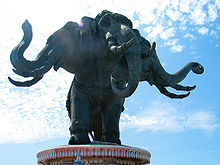Erawan



Erawan (in Thai : เอราวัณ ) is the Thai form of the mythical elephant Airavata .
He's a giant elephant, big as a mountain. It usually has three, sometimes even 33 heads, each head is equipped with seven tusks .
He is the mount of the Hindu god of rain and thunder Indra , the ruler of the Tavatimsa sky , the abode of 33 gods of Vedic origin.
In the 14th century Thai opus Traiphum Phra Ruang , the Erawan is described as follows:
- The 33 Devatā region is located on top of the royal mountain Meru . It is also called the city of Indra , the king of all Devatā. There are jeweled palaces and jeweled prangs . From the east gate of His Majesty King Indra's great city to the west gate it is 80,000,000 Wa . A jeweled wall surrounds the whole city with 1,000 gates in all possible places.
- There is an elephant in town called Erawan . However, this elephant is not an animal because there are no animals in this sky, it is inhabited exclusively by Devatā. There is an elephant named "Devatā Erawan" there. Whenever King Indra wants to ride for pleasure, and he wants to ride an elephant, “Devatā Erawan” turns into a very large white elephant. This elephant is 1,200,000 Wa tall and has 33 heads. There are two smaller heads on the outside of each head. There are larger heads with a circumference of 2,000 Wa, the next heads on the side have a circumference of 3,000 Wa, the next 4,000 Wa, ... The heads towards the middle are getting bigger, the head in the center is called Sudassana . It is the throne of Indra and is 24,000 Wa in circumference. On top of this head there is a palace of jewels, which is covered with seven different types of precious stones. (A description of the interior of the palace follows.) Each of the 33 heads of this elephant has seven tusks, each 40,000 Wa long. In each tusk there are seven pools, in each pool there are seven lotus plants; each lotus plant has seven flowers, each with seven petals. On each petal there are seven female devatā dancing on it. (What follows is a description of Indra's numerous followers, his wives, musicians - 60,000 lute players, 60,000 drummers, etc. - and dancers, who are also all on Sudassana's head.)
Erawan, the big elephant also plays a role in the Asian epic Ramayana (in Thai: Ramakien ): During the siege of the demon city, it was almost impossible for the demons to defeat Phra Ram's troops. Inthorachit ( lord of the three arrows ), brother of the demon leader Thotsakan, resorted to a ruse. He took the form of Erawan, who apparently intervened in battle under the direction of the god Indra. But the clever ape general Hanuman saw through the disguise and with magical power broke the elephant's neck. This episode is shown in the monumental mural in the so-called "Room 76" of the galleries (cloister, Phra Rabieng ) in Wat Phra Kaeo in Bangkok.
Thanks to its ancestry, the white elephant Erawan has the magical ability to make rain: it can summon its heavenly relatives, the rain clouds (see Airavata ). It has become a symbol for many rulers in South and Southeast Asia , whose reputation grew with the number of white elephants in their possession.
With a few exceptions, artists do not depict the Erawan with its thirty-three heads, but only with three heads. Sometimes he even has only one head, such as B. in the coat of arms of the city council of Bangkok . Often his rider, the god Indra, is symbolized only by a palace or only by a crown on the head of the Erawan. It can be found on the gables of sacred buildings such as the viharn of Wat Suthat in Bangkok, or even on bridges. He guards the entrance of the National Stadium in Bangkok or he looks out of the central prang of Wat Arun in Bangkok in all four directions. It stands for the longevity of car tires and plastic pipes.
At the Erawan Shrine in Bangkok, contrary to what the name suggests, neither Erawan nor his rider Indra is sacrificed, but to the god Brahma. The name of the shrine is due to the fact that it stands in front of the Erawan Hotel of the same name. In Thai it is more properly called San Phra Phrom (Brahma Shrine).
Footnotes
- ↑ A Wa is an old measure of length. 1 Yojana contains 8000 Wa. So 1 Wa is about 2 meters (see: Old Weights and Measures (Thailand) )
literature
Frank E. Reynolds (translator): Three worlds According To King Ruang . Berkeley 1982. ISBN 0-89581-153-7
